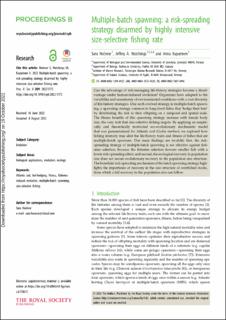Multiple-batch spawning: a risk-spreading strategy disarmed by highly intensive size-selective fishing rate
Peer reviewed, Journal article
Published version
Permanent lenke
https://hdl.handle.net/11250/3027339Utgivelsesdato
2022Metadata
Vis full innførselSamlinger
- Articles [3011]
- Publikasjoner fra CRIStin [3061]
Originalversjon
Proceedings of the Royal Society of London. Biological Sciences. 2022, 289 (1981), . 10.1098/rspb.2022.1172Sammendrag
Can the advantage of risk-managing life-history strategies become a disadvantage under human-induced evolution? Organisms have adapted to the variability and uncertainty of environmental conditions with a vast diversity of life-history strategies. One such evolved strategy is multiple-batch spawning, a spawning strategy common to long-lived fishes that ‘hedge their bets' by distributing the risk to their offspring on a temporal and spatial scale. The fitness benefits of this spawning strategy increase with female body size, the very trait that size-selective fishing targets. By applying an empirically and theoretically motivated eco-evolutionary mechanistic model that was parameterized for Atlantic cod (Gadus morhua), we explored how fishing intensity may alter the life-history traits and fitness of fishes that are multiple-batch spawners. Our main findings are twofold; first, the risk-spreading strategy of multiple-batch spawning is not effective against fisheries selection, because the fisheries selection favours smaller fish with a lower risk-spreading effect; and second, the ecological recovery in population size does not secure evolutionary recovery in the population size structure. The beneficial risk-spreading mechanism of the batch spawning strategy highlights the importance of recovery in the size structure of overfished stocks, from which a full recovery in the population size can follow.
